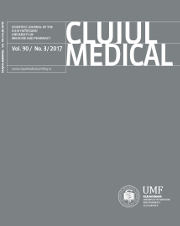The influence of seasonality and weather changes on premature birth incidence
DOI:
https://doi.org/10.15386/cjmed-744Keywords:
preterm delivery, meteorological parameters, exposure, climate changes, seasonalityAbstract
Background. Although the effects of meteorological factors on the general population health are widely documented, little is known about their influence upon human pregnancy and birth. The present study aim to analyze the influence of the atmospheric conditions upon premature births.
Method. One hundred and eight nine cases of premature births were included in the study with a gestational age between 24 to 37 weeks of amenorrhea. Cases with antepartum fetal death and those with uncertain gestational age have been excluded. Daily weather data were obtained using http://www.wunderground.com site.
A Pearson's product-moment correlation was run to assess the relationship between weekly preterm birth incidence and the total number of premature births and the mean maximum and minimum temperature (Tmax, Tmin), maximum and minimum average humidity (Umax, Umin), maximum and minimum atmospheric pressure mean (P max, P min), average wind speed and average quantity precipitations, calculated for one calendar week.
Results. Approximately 7.7% of all births during the study period occurred before 37 weeks of gestation, the main reason for hospitalization being premature rupture of membranes (45%). The analysis revealed a moderate positive correlation between weekly preterm birth incidence and the average temperature ( r = 0.306, n = 52, p = 0.027) and a moderate positive correlation between weekly preterm birth incidence and temperature variation (r = 0.307, n = 52, p =0.007). Our study found no significant statistic correlation between the humidity variation, pressure variation, and wind speed.
Conclusions. The incidence of premature births can be influenced by variations of specific weather factors, especially during the weeks characterized by large fluctuations in temperature. The results obtained might inspire the construction of multicenter studies to investigate thorough the adverse effects of some meteorological factors that can influence the outcomes of human pregnancy.Downloads
Additional Files
Published
How to Cite
Issue
Section
License
The authors are required to transfer the copyright of the published paper to the journal. This is done by agreeing to sign the Copyright Assignment Form. Whenever the case, authors are also required to send permissions to reproduce material (such as illustrations) from the copyright holder.

The papers published in the journal are licensed under a Creative Commons Attribution-NonCommercial-NoDerivatives 4.0 International License.

